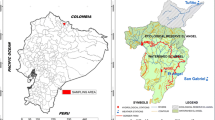Abstract
This paper aims to assess the implications of climate change and human activity on the disaster risk for water resources in the Balkhash Lake drainage basin, which are shared between the Republic of Kazakhstan and the People’s Republic of China. The long-term periodical fluctuations in the Balkhash Lake water levels demonstrate their intimate connection with components of its water regime, especially run-off from its main contributor, the Ili River, which flows from the Republic of China. A rapid increase in human activity in the Kazakh part of the drainage basin in the period 1970–1990 led to a significant drop in the Balkhash water level and devastating effects on wet ecosystems. The reduction of anthropogenic impact in the Balkhash Lake drainage basin after the collapse of the Soviet Union in 1991 coincided with favourable climate conditions during the 1990s and 2000s. This led to a significant rise in the water level in the Balkhash Lake and to the rehabilitation of its degraded ecosystems. However, a new challenge for the sustainable use of Lake Balkhash water resources appeared during the last decade, posed by the development of large irrigated areas in the upper part of the Ili River in the Republic of China. China is planning to reduce considerably the outflow of the Ili into Kazakhstan. Moreover, contemporary climate change causes changes in precipitation and temperature in the drainage basin. The paper presents three different scenarios for the development of the Balkhash Lake in the twenty-first century. The scenarios were simulated with respect to changes in human activity and climate parameters in both parts (Kazakhstan and China) of the Balkhash Lake basin. Two of the scenarios lead to disaster-like changes in the Balkhash Lake.
Access this chapter
Tax calculation will be finalised at checkout
Purchases are for personal use only
Similar content being viewed by others
References
Aisen VB, Aisen EM, Melack J, Dozier J (1997) Climatic and hydrological changes in the Tien-Shan, Central Asia. J Clim 10:1393–1404
Hodgson S (2010) Strategic water resources in Central Asia: in search of a new international legal order. EU-Central Asia Monitoring 14:1–5
Ibatulin S, Yasinsky V, Mironenkov A (2009) The impact of climate change on water resources in Central Asia. Eurasian Development Bank, Industry Report No. 6
Kazakhstan TACIS/European Union Program (2005) Development of Ili-Balkhash basin integrated management plan: project results. http://www.waterwiki.net/images/8/8e/CA-REC_ili-Balkhash_Result_Buklet_Eng.pdf. Available 4 Oct 2010
Kezer K, Matsuyama H (2006) Decrease of river runoff in the Lake Balkkhash basin in Central Asia. Hydrol Process 20:1407–1423
Kipshakbaev NK, Abdrasov SA (1994) Effects of economic activity on the hydrologic regime and dynamics of the Ili delta. Hydrotech Constr 28:416–420
Matsuyama H, Kezer K (2009) Long-term variation of precipitation around Lake Balkhash in Central Asia from the end of the 19th century. SOLA 5:73–76
Moerlins JE, Khankhasayev MK, Leitman SF, Makhmudov EJ (eds) (2006) Transboundary water resources: a foundation for regional stability in Central Asia. In: Proceedings of the NATO advanced research workshop on facilitating regional security in central Asia through improved management of transboundary Water basin resources, Almaty, Kazakhstan. Springer, Berlin, 20–22 June 2006
Pahl-Wostl C (2007) Transition towards adaptive management of water facing climate and global change. Water Resour Manage 21:49–62
Petr T (1992) Lake Balkhash Kazakhstan. Int J Salt Lake Res 1:21–46
Polat N (2002) Boundary issues in Central Asia. Transnational Publishers, New York, pp 99–151
Propastin P (2011) Problems of water resource management in the drainage basin of Lake Balkhash with respect to political development. In: Leal Filho W (ed) Climate change and the sustainable management of water resources. Springer, Berlin
Propastin PA, Kappas M, Muratova NR (2007) Change detection of the Ili delta in the Seven-Stream Land using multi-temporal remote sensing data. In: Kappas M, Kleinn C, Sloboda B (eds) Global change issues in develo** and emerging countries, Proceedings of the 2nd international conference “Goettingen GIS and remote sensing days”, Goettingen, Germany, pp 239–251, 3–5 Oct 2007
Ratkovich DY, Ivanova LV, Novikova NM, Frolov AV (1990) The problem of lake Balkhash. Vodnye Resursy 3:5–23 (Russian)
Shnitnikov AV (1973) Water balance variability of lakes Aral, Balkhash, Issyk-Kul and Chany. In: Hydrology of lakes, Proceedings of the international symposium. Adlard and Son, Bartholomew Press, Dorking, IAHS-AISH Publication No. 109, pp 130–140. http://www.iahs.info/redbooks/109.htm. Available 17 Sept 2011
Tlenbekov OK, Piven EN (1993) Anthropogenic change in runoff of the rivers in the Balkhash Lake basin. In: Tursunov AA (ed) Geographic problems of the Ili-Balkhash region. Galym-Publishers, Almaty, pp 54–62
Tursunov AA (2002) From the Aral lake to the Lobnor lake: hydrology of the dischargeless drainage basins of Central Asia. Galym-Publishers, Almaty
UNECE (2009) Guidance on water and adaptation to climate change. United Nations Economic Commission for Europe, Convention on the protection and use of transboundary watercourses and international lakes, Geneva, Switzerland. http://www.unece.org/env/water/publications/assessment/assessmentweb_full.pdf. Available 17 Sept 2011
Author information
Authors and Affiliations
Corresponding author
Editor information
Editors and Affiliations
Rights and permissions
Copyright information
© 2013 Springer-Verlag Berlin Heidelberg
About this chapter
Cite this chapter
Propastin, P. (2013). Assessment of Climate and Human Induced Disaster Risk Over Shared Water Resources in the Balkhash Lake Drainage Basin. In: Leal Filho, W. (eds) Climate Change and Disaster Risk Management. Climate Change Management. Springer, Berlin, Heidelberg. https://doi.org/10.1007/978-3-642-31110-9_3
Download citation
DOI: https://doi.org/10.1007/978-3-642-31110-9_3
Published:
Publisher Name: Springer, Berlin, Heidelberg
Print ISBN: 978-3-642-31109-3
Online ISBN: 978-3-642-31110-9
eBook Packages: Business and EconomicsEconomics and Finance (R0)




